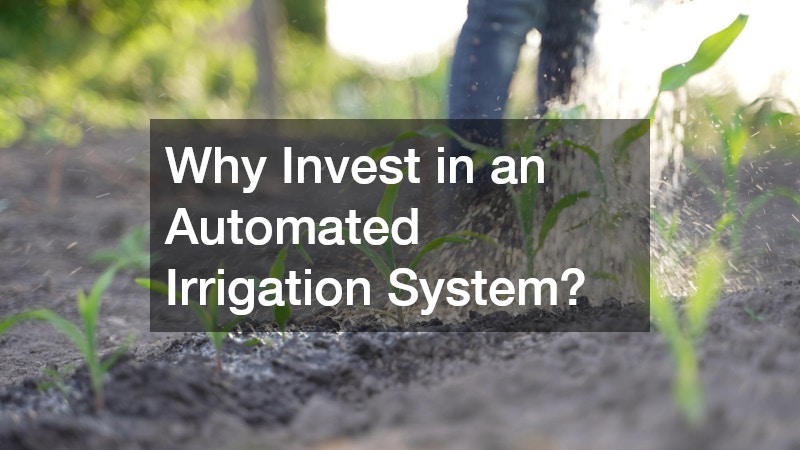Automated irrigation systems are increasingly popular among homeowners and commercial properties, revolutionizing the way we manage water usage in landscapes. These systems provide a technologically advanced solution to the age-old problem of efficient water management, ensuring optimal growth conditions for a variety of plant species. With growing concerns over water scarcity and environmental impact, adopting an automated system has become a wise choice for many property owners.
What are the Benefits of an Automated Irrigation System?
Water Conservation
Automated systems optimize water usage through scheduled and sensor-based irrigation, significantly reducing waste. Sensors detect soil moisture levels and weather conditions, adjusting watering schedules accordingly to prevent over-irrigation. This precise approach not only supports sustainability efforts but also ensures plants receive the right amount of water for their health and growth.
Worldwide, water conservation is becoming essential as freshwater resources dwindle. By implementing automated irrigation, users contribute to global efforts to reduce water consumption, aligning with broader environmental goals. This technology plays a crucial role in landscape management, particularly in areas prone to drought or water restrictions.
Time Savings
By eliminating the need for manual watering, automated systems provide convenience and allow users to allocate their time to other tasks. Homeowners no longer need to spend hours regulating water flow to different garden areas, as the system handles it all autonomously. The initial setup and occasional monitoring are all that is required, freeing up valuable time each week.
The automation not only saves time but also reduces the physical effort involved in maintaining a lawn or garden. This independence means that gardens can be cared for even while the owner is away, eliminating worries about who will take care of the yard. Such convenience adds value to any property by ensuring it remains lush with minimal manual input.
Cost Efficiency
While the initial investment may be high, the savings on water bills and plant maintenance over time can offset the costs. Initial expenses include purchasing components like timers, sensors, and controllers, but these costs are mitigated by long-term savings. Automated irrigation systems can reduce water use by up to 50%, leading to significant reductions in monthly utility bills.
Additionally, healthier plants require less frequent replacement, which decreases overall maintenance costs. The ability to target exact areas for hydration prevents wastage and enhances soil and plant health, reducing the need for fertilizers and other chemical inputs. Over time, these savings can significantly outweigh the costs of the initial setup and maintenance.
How Does an Automated Irrigation System Work?
Components
The system comprises timers, sensors, valves, and controllers that work together to deliver precise irrigation. Timers allow users to set specific periods for watering, ensuring that irrigation occurs during optimal times of day. Sensors monitor soil conditions and weather, triggering the controller to adjust watering patterns accordingly.
Controller units are the “brain” of the system, processing data from connected devices to automatically dispense water efficiently. Valves serve as the physical gates that regulate water flow, opening and closing as directed by the controller. This integration of technology ensures that each landscape area receives the correct amount of moisture, thus promoting healthy growth.
Installation Process
The installation involves setting up the system components, programming, and ensuring proper connection to the water source. A clear understanding of the landscape’s layout is necessary to effectively plan the placement of pipes, valves, and emitters. Professional installation is recommended to avoid common pitfalls and ensure the system functions correctly from the start.
Once the hardware is installed, the system is programmed to suit the specific water needs of the landscape. This involves setting schedules and configuring sensors to communicate with the controller based on live feedback. Proper calibration of the system ensures that all components work in harmony to provide efficient water distribution.
Maintenance and Upkeep
Regular maintenance includes checking for clogs, leaks, and ensuring all parts are operating effectively, which is crucial for system longevity. Over time, soil, minerals, and debris may block emitters, reducing efficiency and wasting water. Routine inspection of all system parts prevents minor issues from becoming costly repairs.
Seasonal maintenance involves winterization, where systems are drained to prevent freeze damage and ensure readiness for spring operation. In addition, calibrating the system with seasonal changes helps adjust water output according to varying weather conditions. Consistent upkeep prolongs system life and maintains optimal performance.
Is an Automated Irrigation System Suitable for My Landscape?
Assessing Your Needs
Analyzing soil type is vital as sandy, clay, or loamy soils affect water retention and absorption rates. Also, evaluating the landscape’s size and complexity guides the layout and zoning of the irrigation system. A well-considered assessment leads to a system tailored to your garden or lawn’s precise requirements.
System Compatibility
Evaluate the compatibility of various systems with existing landscapes and the potential for future expansions. Existing irrigation systems can be upgraded with automated components, fostering seamless transitions. Compatibility assessments ensure that new installations work harmoniously with established infrastructure.
Cost Considerations
Understanding the cost implications, including installation, equipment, and potential long-term savings, is crucial for budget planning. Initial purchase and setup costs are balanced by decreased water usage and reduced plant maintenance expenses over time. Evaluating these factors provides a comprehensive overview of investment value.
While upfront costs may seem high, the maintenance and operational savings can significantly offset this over the years. Customized solutions according to landscape needs ensure water is used judiciously, which directly contributes to lower utility expenses. A robust cost-benefit analysis empowers property owners to make informed investment decisions.
Investing in an automated irrigation system can offer substantial benefits in water conservation, convenience, and cost savings while ensuring a healthy and lush landscape. These systems integrate cutting-edge technology to manage water resources effectively, promoting sustainable gardening practices. Automated irrigation represents a smart investment for both homeowners and commercial enterprises looking for efficiency and environmental impact reduction.
.




